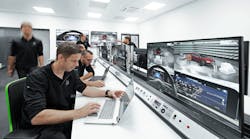By now, most manufacturers are familiar with what digital twins are and how they work. But not as many are familiar with the new possibilities they can create for a business, its partners and its customers. In its 2019 IoT implementation survey, Gartner found that 13% of organizations with IoT-related capabilities already are using digital twins, while another 62% are either in the process of implementing them or planning to do so.
A digital twin simulates not only the design and manufacture of a product, but how that product will perform throughout is life. Data collected during the manufacturing process, as well as during actual end-use of the product, creates a loop for the continuous optimization of production and product performance in the real world. At auto manufacturer Daimler, the goal, says company CIO Jan Brecht, is to develop a digital twin of every Mercedes passenger car it produces, providing common threads of data and insight that run internally, from research and development, manufacturing and sales, and externally, to its dealers worldwide, and ultimately to the end consumer.
“With a digital twin, we will be able to offer digital test drives with the very configuration that has been created either on a mobile or desktop device or directly at the local dealer, thereby also saving cost,” Brecht says. “Software updates will happen remotely, thereby saving time and money. And depending on what services our customer wishes to use, we can suggest products or services in real-time. The digital twin will be an essential part of our company.”
The digital twin construct invites community insight-sharing and collaboration along the value chain, creating in essence an intelligent asset network. Nearly one-third of digital twin users in the Gartner survey say their digital twins serve multiple constituencies, not just their own operations. “We see digital twin adoption in all kinds of organizations,” observed Gartner’s Benoit Lheureux. “However, manufacturers of IoT-connected products are the most progressive, as the opportunity to differentiate their product and establish new service and revenue streams is a clear business driver.”
Indeed, manufacturers have been busy launching new digital twin-enabled services and revenue streams for everything from robots to refrigerators. Digital twins developed by Mitsubishi Electric, which designs and makes controllers, robots and other devices and components for industrial use, give the manufacturer as well as its operator customers visibility into plant and process data to inform predictive maintenance. Mitsubishi says it sees the cloud-based digital twin serving not only as a hub for storing, accessing and analyzing process equipment performance data, but also as a service portal where customers can access documentation, 3D models and maintenance specs, create service tickets and order replacement parts (which could be produced on demand by a 3D printer).
Also in the manufacturing space, INDEX Group, which supplies the automotive industry with machines for producing engine parts, has built a new business model powered by digital twin. Instead of purchasing equipment outright, customers subscribe to INDEX’s iXworld platform, where they gain access to real-time data on equipment performance and condition as a means of improving shop floor processes, plus a knowledge database they can use to train employees. Soon INDEX plans to launch a service where customers can rent equipment bundled with software, monitoring and maintenance.
Not only can a digital twin play a key role in “servitizing” the manufacturing business model, it also can make “segment of one” mass customization a viable manufacturing proposition, providing the digital platform on which various entities along the supply chain (manufacturer, component supplier, customer, etc.) can collaborate to co-develop products. With embedded machine learning and artificial intelligence tools in the cloud, plus data from sources along the supply chain, that platform can enable a manufacturer to differentiate core production processes, and to speed and improve decision-making during the collaborative design and development process.
Markus Krabel is chief technology officer for the industrial machinery and components, and automotive industry, within the SAP industry business units. He joined SAP in 1997, and has worked in business consulting, product development and the industry solution management.




